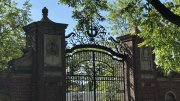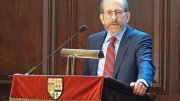A Harvard presidential search naturally culminates in the appointment of a new Harvard president. (For coverage of the announcement of Lawrence S. Bacow as twenty-ninth president on February 11, after this issue went to press, see harvardmag.com/bacow-18). But a good search also surfaces ideas that resonate beyond the announcement proper. Herewith, some thoughts overheard while the bushes were being beaten.
Build a lot of housing, and a school. Harvard is erecting its science and engineering center in Allston, and has revealed a tiny glimpse at its plans for commercial development of an “enterprise research zone” nearby, closer to the Charles River and the Mass. Pike (see “News Briefs”). In the meantime, if the University is to have a reasonable hope of hiring young professors, it needs to build a lot of family-friendly apartments there, too, at rents below Greater Boston’s unreasonable residential market. (From Allston neighbors’ perspective, Harvard’s institutional development worsens local traffic problems, as a mass-transit hub for the area is delayed until 2040.) The University must welcome young faculty members and postdocs; supply adequate daycare; and aim for a large enough cohort so other young stars will be attracted as well. And why not build a magnet school (as Penn did), so they can educate their children locally, while providing the Graduate School of Education a laboratory for innovations and best practices?
Study abroad, at home. At a time of intense political polarization in the United States, and pronounced sorting among red and blue states, the geographic listings in freshman registers suggest that the College draws its students most heavily from Democratic-leaning states and probably from blue counties within redder parts of the country. And given the economic allure of California, Massachusetts, New York, and environs, it is likely that graduates concentrate at least as much in the coastal blue regions, if not more so. How about instituting an exchange program so Harvard undergraduates spend a semester at a “flyover-state” institution, and counterparties come to this campus for a Crimson immersion—just to incite some cultural and sociopolitical dialogue along those dimensions of diversity?
Transparency. The public, or at least their elected representatives, are increasingly impatient with endowed private colleges and universities (hence the new tax on some institutions’ investment income; see “Endowments, Taxed”). Even many of the University’s supporters clearly do not understand how the endowment works; how it is invested; or Harvard’s and the schools’ budgets. Their confusion is understandable, in light of the prevailing scanty disclosures (exacerbated last fall when the new Harvard Management Company [HMC] leadership, working to improve results, declined to provide customary details about the distribution of endowment assets, performance by class, or even long-term rates of return). Transparency might work better: a public budget, and a report on results compared to the plan; disclosure of capital-project costs; and some light shed on assessments on endowment distributions to fund administration, overhead, and University academic priorities.
Consider an internal, Allston-related case in point. Harvard has been assembling land since the 1980s, so it is obviously encouraging that it is at last building academic facilities there: the billion-dollar science complex. But questions remain. The central administration undertook to finance this facility; did it do so through its assessments on other schools’ endowments? It will own the completed building; will it lease it on concessionary terms to the School of Engineering and Applied Sciences (which would strain to pay the costs of amortizing construction, operating, and depreciating its nifty new quarters)? Either step confers on one school a valuable subsidy that others do not routinely enjoy; what does that say for Harvard’s academic model and priorities going forward—and what do these decisions imply for the next Allston building? And for envisioned investments in the life sciences? Absent clear information, expect rumors and resentments.
Compensation. No fair person doubts that running an enterprise like Harvard is demanding, sometimes even killing, work. But the presidency remains a high academic honor, and a form of nonprofit service. Harvard cannot do anything about the seven-digit salaries commanded by the heads of its affiliated hospitals (a tempting target amid gigantic healthcare costs), and is apparently at the mercy of the investment-management market in setting the pay needed to hire talent for HMC. But Congress fired a warning shot in assessing a 21 percent tax on the annual compensation in excess of $1 million given to the five highest-paid employees of nonprofit organizations, including universities. The Corporation ought to consider what signals it sends when it sets the president’s compensation, awards deferred “retention” bonuses (increasingly popular in higher education), and allows leaders to serve on (richly compensated) corporate boards. Apart from the optics, there is a point beyond which the culture of a nonprofit institution breaks down.
Expenses. Administrators emphasize Harvard’s revenue problem: tuition growth, net of financial aid, is constrained; federal funding for research is threatened by deficits and changing political priorities; endowment investment returns are uncertain (and now subject to taxation). All true. Supporters have been generous with gifts. Executive and continuing education continue to grow. Foundation and corporate sponsors are supporting more research. But tougher talk about expectations may be warranted. In fiscal year 2008, Harvard spent $3.5 billion. In fiscal 2017, it spent $4.9 billion—for a student body and faculty of approximately the same size, and during a period of continued modest inflation. It may not forever be so lucky.
Allston encore. The Corporation and administration point to Allston as a significant opportunity to expand this world-important institution, adjacent to its existing footprint (see harvardmag.com/lee-17). And so it is—but it is not risk-free. The costs and difficulties of proceeding have proven large and protracted. The ways in which people interact are evolving, digitally and across boundaries worldwide. The University has other expensive needs and priorities, too. What is the process for reassessing Allston in light of changing circumstances? Holding aside the potential financial returns from the enterprise zone, locking the institution into a multibillion-dollar, decades-long program of academic real-estate development in effect anchors it in the most fixed of costs. Only a decade ago, overly ambitious plans for Allston deepened the entire institution’s financial woes, and it continues to have sunk costs there totaling at least hundreds of millions of dollars (see transparency, above). It would be well for the Corporation and the new president to explain clearly the factors separating aspiration from albatross.
~John S. Rosenberg, Editor








